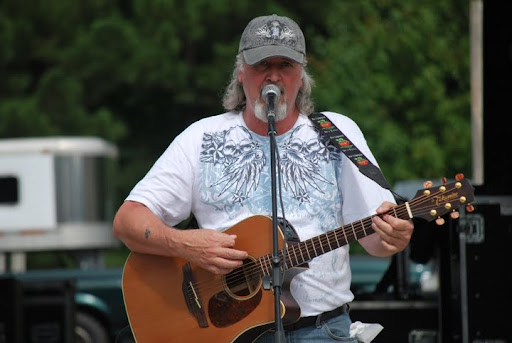Larry B Hester
age ~74
from West Carrollton, OH
- Also known as:
-
- Larry C Hester
- Larry N Hester
- Lawrence B Hester
- Larry B Hestor
- Laurence B Hester
- Larryc Hester
- Rebecca Hester
- Larry Hess
- Phone and address:
-
2548 Eckley Blvd, Dayton, OH 45449
9374344565
Larry Hester Phones & Addresses
- 2548 Eckley Blvd, Dayton, OH 45449 • 9374344565
- West Carrollton, OH
- Byrdstown, TN
- Albany, KY
- 2548 Eckley Blvd, Dayton, OH 45449
Us Patents
-
Wheel Hub With Lubricant Fill Port
view source -
US Patent:7585031, Sep 8, 2009
-
Filed:Jul 26, 2007
-
Appl. No.:11/828546
-
Inventors:Jay D. White - Massillon OH, US
Larry B. Hester - Dayton OH, US
Kenneth D. Mutzner - Logan OH, US
Michael W. Wilcheck - Kettering OH, US -
Assignee:Hendrickson USA, L.L.C. - Itasca IL
-
International Classification:B60B 27/00
-
US Classification:3011051, 3011084, 384544
-
Abstract:A non-drive axle depends from a heavy-duty vehicle. Each one of a pair of wheel end assemblies is mounted on a respective one of the ends of the non-drive axle. Each wheel end assembly includes a pair of bearings mounted on a spindle of the axle, and a wheel hub rotatably mounted on the bearings. A cavity is formed in the wheel end assembly between the bearings. A port is formed in the wheel hub and extends generally parallel to a central axis of the wheel hub, and communicates with the outboard surface of the wheel hub and the cavity. Lubricant for the bearings is introduced into the cavity by means of the port, and the port is tapped to receive a plug to seal it and contain the lubricant in the cavity. The port also receives a bolt that secures a hubcap to the wheel hub.
-
Disc Brake Assembly With Tone Ring
view source -
US Patent:7980367, Jul 19, 2011
-
Filed:Jan 30, 2008
-
Appl. No.:12/022698
-
Inventors:Larry B. Hester - Dayton OH, US
-
Assignee:Walther Engineering And Manufacturing Company, Inc. - Franklin OH
-
International Classification:F16D 65/10
-
US Classification:188218XL, 188 18 A, 3011051
-
Abstract:A disc brake assembly including a rotor defining a rotational axis and including a barrel portion and a disc portion extending generally radially outward from the barrel portion, the barrel portion defining an inner surface and the inner surface defining a groove, a biasing element received in the groove, and a tone ring having an outer surface and including a step formed on the outer surface, the tone ring being positioned in the barrel portion such that the step is aligned for engagement with the biasing element.
-
Disc Brake Assembly
view source -
US Patent:8584815, Nov 19, 2013
-
Filed:Jul 1, 2011
-
Appl. No.:13/175035
-
Inventors:Larry B. Hester - Dayton OH, US
-
Assignee:Walther Engineering And Manufacturing Company, Inc. - Franklin OH
-
International Classification:F16D 65/10
-
US Classification:188218XL, 188 18 A, 3011051
-
Abstract:A disc brake assembly having a rotor defining a rotational axis and including a barrel portion and a disc portion extending generally radially outward from said barrel portion, the barrel portion including a tone ring receiving portion with a generally cylindrical inner surface having a tone ring receiving surface and a groove with an axially outer wall, an axially inner wall and a radially outer bottom surface; a generally annular tone ring positioned concentrically within said cylindrical inner surface of said tone ring receiving portion and having a generally radially facing outer surface; a resilient biasing element received in the groove and having a generally annular shape including a plurality of substantially linear segments and corners, the resilient biasing element may be shaped such that it is flexed when seated within the groove so that the corners are urged against the radially facing outer surface, and the substantially linear segments are urged against the axially outer wall and the radially facing outer surface of the tone ring to prevent separation of the tone ring from the rotor during use. In one aspect, the biasing element is formed in the shape of a regular polygon, such as a dodecahedron.
-
Final Balanced Brake Drum Having Integral Squealer Band And Method For Producing Same
view source -
US Patent:62796992, Aug 28, 2001
-
Filed:Nov 23, 1999
-
Appl. No.:9/444614
-
Inventors:Larry B. Hester - Dayton OH
Jay K. Julow - Novi MI
Robert A. DeRegnaucourt - Centerville OH
John C. Hall - Kettering OH -
Assignee:Meritor Automotive, Inc. - Troy MI
-
International Classification:B23C 334
-
US Classification:188218R
-
Abstract:An improved method for final balancing a brake drum determines the location and length of a first constant depth cut and a second constant depth cut along the squealer band which are necessary to correct the imbalance, and using a cutting machine, makes the first and second constant depth cuts at the predetermined location and for the predetermined length along the squealer band to produce a final balanced brake drum. Preferably, the cutting machine is a milling machine which produces a plunge type entrance/exit cut. It is a further feature of the invention to provide a feather type entrance/exit cut to reduce the stress concentrations, and produce a cosmetically more appealing final balanced brake drum.
-
Prestressed Brake Drum Or Rotor
view source -
US Patent:53523059, Oct 4, 1994
-
Filed:Oct 16, 1991
-
Appl. No.:7/778438
-
Inventors:Larry B. Hester - Dayton OH
-
Assignee:Dayton Walther Corporation - Dayton OH
-
International Classification:B21D 5334
-
US Classification:148581
-
Abstract:Uniformly distributed compressive stresses are induced in the machined surfaces of brake drums and brake rotors. The compressive stresses cancel residual tensile stresses induced in the surfaces by machining operations during fabrication. Cancellation of the surface tensile stresses delays formation of cracks during brake service use and extends the service life of the brake drum or rotor. Shot peening is an applicable prestressing process which also imparts a surface roughness that reduces the time required to burnish bake pads to match the shape of the drum or rotor surface. The reduction of burnishing time reduces the amount of surface cracking caused by surface heating by brake pad high spots as the high spots are ground down.
-
Prestressed Brake Drum Or Rotor
view source -
US Patent:56646488, Sep 9, 1997
-
Filed:Oct 4, 1994
-
Appl. No.:8/317789
-
Inventors:Larry Bennett Hester - Dayton OH
-
Assignee:Dayton Walther Corporation - Dayton OH
-
International Classification:B21D 5334
F16D 6510 -
US Classification:188218R
-
Abstract:Uniformly distributed compressive stresses are induced in the machined surfaces of brake drums and brake rotors. The compressive stresses cancel residual tensile stresses induced in the surfaces by machining operations during fabrication. Cancellation of the surface tensile stresses delays formation of cracks during service brake use and extends the service life of the brake drum or rotor. Shot peening is an applicable prestressing process which also imparts a surface roughness that reduces the time required to burnish brake pads to match the shape of the drum or rotor surface. The reduction of burnishing time reduces the amount of surface cracking caused by surface heating by brake pad high spots as the high spots are ground down.
-
Final Balanced Brake Drum Having Integral Squealer Band And Method For Producing Same
view source -
US Patent:63218860, Nov 27, 2001
-
Filed:May 4, 2001
-
Appl. No.:9/849200
-
Inventors:Larry B. Hester - Dayton OH
Jay K. Julow - Novi MI
Robert A. DeRegnaucourt - Centerville OH
John C. Hall - Kettering OH -
Assignee:Meritor Heavy Vehicle Technology, LLC
-
International Classification:F16D 6510
B23C 334 -
US Classification:188218R
-
Abstract:An improved method for final balancing a brake drum determines the location and length of a first constant depth cut and a second constant depth cut along the squealer band which are necessary to correct the imbalance, and using a cutting machine, makes the first and second constant depth cuts at the predetermined location and for the predetermined length along the squealer band to produce a final balanced brake drum. Preferably, the cutting machine is a milling machine which produces a plunge type entrance/exit cut. It is a further feature of the invention to provide a feather type entrance/exit cut to reduce the stress concentrations, and produce a cosmetically more appealing final balanced brake drum.
-
Brake Drum Having Ribs On Drum Outer Surface
view source -
US Patent:58266844, Oct 27, 1998
-
Filed:Dec 6, 1996
-
Appl. No.:8/762104
-
Inventors:Larry B. Hester - Dayton OH
-
Assignee:Dayton Walther Corporation - Dayton OH
-
International Classification:F16D 6510
-
US Classification:188218R
-
Abstract:An improved structure for a brake drum adapted for use in a drum brake assembly includes a generally closed outer end, a generally axially extending cylindrical main body, and an open inner end. The closed outer end of the brake drum includes a centrally located wheel spindle opening formed therein, and a plurality of lug bolt mounting holes spaced circumferentially around the wheel spindle opening. The cylindrical main body of the brake drum includes a plurality of generally axially extending raised ribs provided on an outer surface thereof. Preferably, the ribs define at least three distinct strengthened areas on the brake drum.
Name / Title
Company / Classification
Phones & Addresses
MM
Hydrojet Technology, LC
Resumes

Larry Hester
view source
Larry Hester
view source
Larry Hester
view source
Larry Hester
view source
Larry Hester
view source
Larry Hester
view source
Larry Hester
view sourceLicense Records
Larry Patrick Hester
License #:
55582 - Expired
Category:
Nursing Support
Issued Date:
Dec 21, 2005
Effective Date:
Dec 31, 2008
Expiration Date:
Dec 21, 2008
Type:
Medication Aide
Classmates

Larry Hester
view sourceSchools:
Lebanon High School Lebanon KY 1959-1963
Community:
Phyllis Lawson, Kermit Johnson, Emily Hourigan, Charles Napier

Larry Hester
view sourceSchools:
Garfield High School Garfield WA 1952-1956
Community:
Gregory Beal, Robert Wilkins, Sharaana Horton, Nancy Stallings, Terry Brooks

Larry Hester
view sourceSchools:
Cherokee Vocational School Cherokee AL 1960-1966
Community:
Carolyn Yarbrough, Robert Malone, Rebecca Hardy, Dianne Roden

Larry Hester
view sourceSchools:
Study Middle School Springfield MO 1965-1969
Community:
Edith Phillips, Joy Baldwin, Rebecca Langle, Gregory Herd, Jim Mills, Boyd Andrus, Judy Marshall, Wayne Miller, Norina Waggoner, Vonita Daniels

Larry Hester
view sourceSchools:
Dewar High School Dewar OK 1964-1968
Community:
Sharon Hughes, Raymond Couch, Randy Cindle, Barbara Owens, Terry Payne, Debee Rutland, Calvin Gresham, Robert Pulliam, Glenda Ellison, Bob Mouser, Audra Johnson, Ginger Albertson

Larry Hester
view sourceSchools:
Hillside High School Durham NC 1965-1969
Community:
Debbie Jackson, Jacqueline Williams, Gail Worley, Sandra Howell, Anthony Ford, David Billings, Katrina Joanne, Brenda Smith, Irene White, Tonia Butler

Larry Hester, Blaine High...
view source
Study Middle School, Spri...
view sourceGraduates:
Larry Hester (1965-1969),
Kelly Risley (1985-1987),
Mark Penick (1994-1995),
Crystal Wright (1985-1989),
Bradley Cover (1989-1999),
Sheryl Pierce (1977-1979)
Kelly Risley (1985-1987),
Mark Penick (1994-1995),
Crystal Wright (1985-1989),
Bradley Cover (1989-1999),
Sheryl Pierce (1977-1979)
Youtube
Plaxo

Larry Hester
view sourceVirginia BeachTrustee at HITVA

larry hester
view sourceSenior Chief Petty Oficer at US Navy

Larry Hester
view source
Larry Hester
view source
Larry Hester
view source
Larry Hester
view source
Larry Denise Hester
view source
Larry Hester
view source
Larry R Hester
view source
Larry Hester
view sourceMyspace
Googleplus

Larry Hester
Work:
Complex - Associate Editor - Video Games
Tagline:
He can stay here and guard the base.

Larry Hester

Larry Hester

Larry Hester

Larry Hester

Larry Hester

Larry Hester

Larry Hester
Get Report for Larry B Hester from West Carrollton, OH, age ~74





